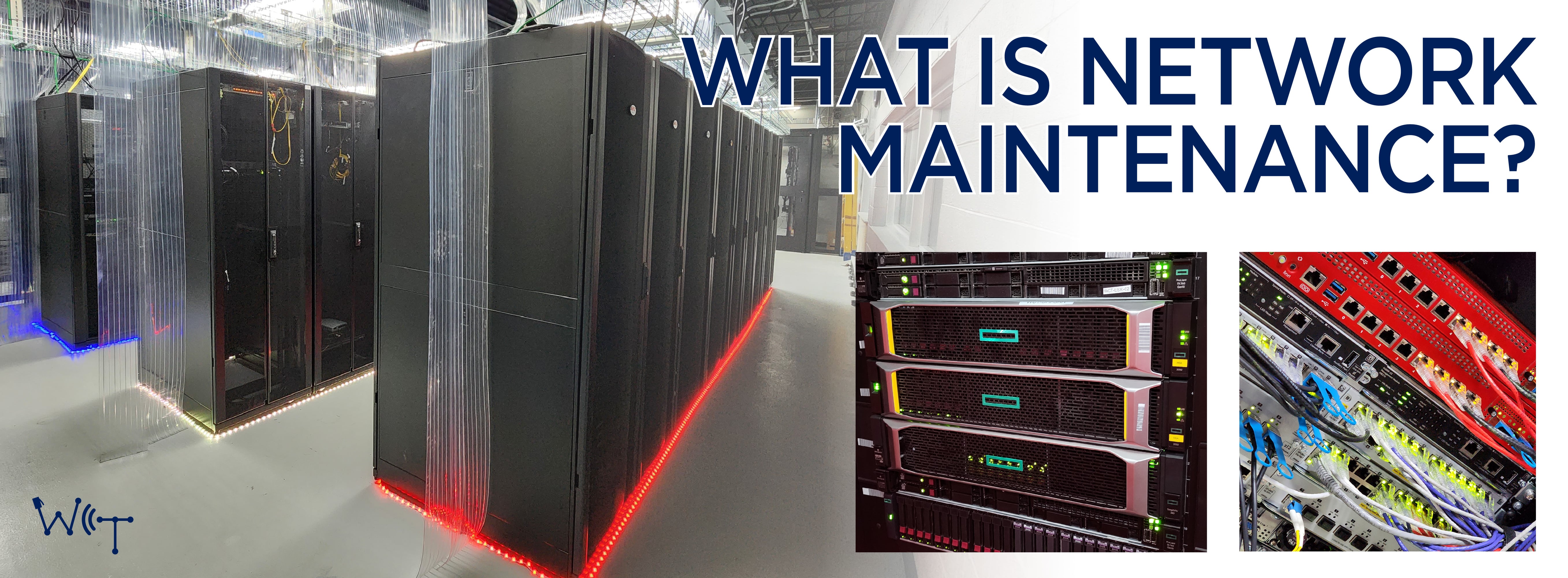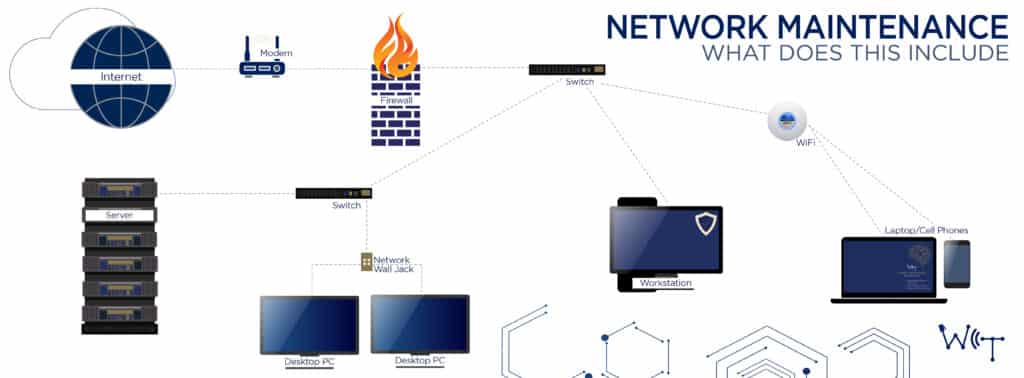
What Is Network Maintenance?
Network maintenance involves all the tasks and systems necessary to monitor, update, and operate your organization’s IT network efficiently. This process helps prevent issues before they occur, safeguarding the physical and non-physical assets that make up your IT environment.

Just like other business functions, a well-maintained IT environment relies on proactive daily activities rather than reactive, last-minute fixes. Network maintenance encompasses several key areas:
- Cybersecurity: Establishing strong defenses with firewalls, VPNs, access controls, multi-factor authentication, EDR, and regularly reviewing configurations to ensure they meet security standards.
- Performance: Monitoring bandwidth, traffic, server reliability, and connection speeds to ensure optimal network performance.
- Scalability: Ensuring your network infrastructure can support current and future operations, including hardware, software, and user needs.
- Updates: Scheduling regular firmware and software updates to maintain both security and performance.
- Preemptive Repairs: Using data and analytics to identify and fix issues before they escalate into larger problems.
Who Conducts Network Maintenance?
There are three primary methods for managing network maintenance:
- Internal IT Staff: In-house IT teams handle all aspects of network management, including security, monitoring, and compliance.
- Original Equipment Manufacturers (OEM): Many software and hardware vendors offer maintenance contracts, providing updates and system audits. However, OEM plans may not offer comprehensive solutions.
- Third-Party Maintenance (TPM): Outsourcing network maintenance to a TPM provider offers more customized and cost-effective solutions, often including broader services across multiple OEMs and IT systems.
The size of your organization, IT staff capabilities, and budget determine which approach best suits your network maintenance needs.
What Is a Network Maintenance Plan?
A network maintenance plan is a service designed to keep your systems running smoothly. This includes updates, installations, and audits to detect potential issues. While OEM contracts offer some maintenance services, they are often inflexible and expensive. TPM providers, on the other hand, can oversee your entire system, offer tailored solutions and budget-friendly plans that align with your specific needs.
Common Network Maintenance Tasks
To ensure your network is in top condition, several routine tasks are typically involved:
- Troubleshooting Known Issues: Identifying and resolving problems early to prevent costly disruptions.
- Product Installation and Configuration: Ensuring new equipment and software updates are correctly installed and configured.
- Monitoring and Enhancing Performance: Regularly analyzing network performance to improve efficiency.
- Planning for Growth: Ensuring your network can scale seamlessly as your business expands.
- Security: Implementing strong security measures, including firewalls and intrusion prevention systems, to protect your network from breaches.
- Backups: Testing backup infrastructure and backup data to ensure it is healthy in case a restore event is required.
Hardware Devices Commonly Serviced in Network Maintenance
Network maintenance involves a variety of hardware, such as:
- Servers: Manage network resources and require maintenance due to their critical role in business operations.
- Storage: Houses data for server applications and server backups.
- Switches: Direct data between sources and destinations within a network, preventing communication disruptions.
- Wireless Access Points: Provides wireless networking functionality to an existing network for mobile devices.
- Firewalls: Secures the perimeter of the network from the internet and connects different networks and enables efficient data transmission between them.
- UPS (Uninterruptible Power Supply): Provides surge protection and battery backed power for all infrastructure devices in the event of a power outage.
Approaches to Network Maintenance
There are two main approaches to maintaining a network:
- Interrupt-Driven: Maintenance is only performed after a problem arises, leading to higher risks of downtime and costly repairs.
- Structured: Regular, proactive maintenance to prevent issues before they impact the network. This approach minimizes disruptions and ensures your systems run smoothly.
Network Maintenance Schedule
A structured network maintenance plan involves regular monitoring and updates to ensure your servers, storage, hardware, and software remain in optimal condition. This helps identify and address potential problems before they cause business disruptions.
Key Areas of Preventative Network Maintenance
Effective network maintenance includes:
- 24/7 Monitoring and Defense: Round-the-clock tracking of network activity, along with advanced threat detection, antivirus protection, and routine data backups.
- Device Maintenance: Ensuring all physical devices are up to date and functioning properly.
- Storage Maintenance: Keeping storage systems reliable and scalable, while making cost-effective investments in new technologies.
- Performance Management: Continuously improving network performance through data analysis and quality of service updates.
Why Do You Need Network Maintenance?
Implementing a network maintenance plan provides numerous benefits, such as:
- Supporting Infrastructure Growth: As your organization expands, network maintenance ensures seamless integration of new systems, data, and devices.
- Robust Data Recovery: Regular backups and recovery plans protect your business from costly data losses.
- Enhanced Network Visibility: Performance reports offer insights into network usage, allowing you to optimize resources and scale efficiently.
- Improved Cybersecurity: Proactive maintenance protects your organization from security breaches and keeps your systems safe.
Ultimately, network maintenance is essential for keeping your IT infrastructure running smoothly, mitigating risks, and supporting business growth. By taking a proactive approach, you can prevent costly disruptions and ensure your organization remains competitive in today’s digital landscape.
